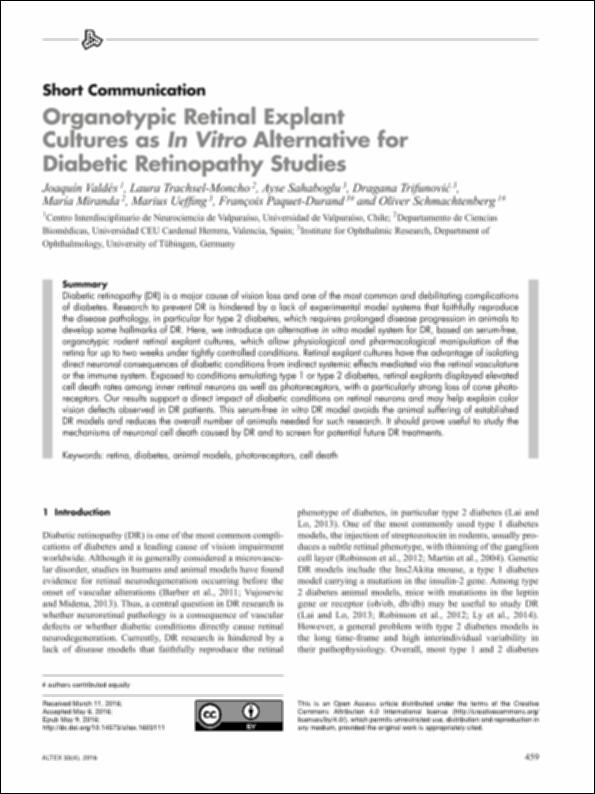Please use this identifier to cite or link to this item:
http://hdl.handle.net/10637/10608Organotypic retinal explant cultures as in vitro alternative for diabetic retinopathy studies
| Title: | Organotypic retinal explant cultures as in vitro alternative for diabetic retinopathy studies |
| Authors : | Valdés, Joaquín Trachsel Moncho, Laura Sahaboglu, Ayse Trifunović, Dragana Miranda Sanz, María Ueffing, Marius Paquet-Durand, François Schmachtenberg, Oliver |
| Keywords: | Diabetes - Complicaciones y secuelas.; Muerte celular.; Diabetic retinopathy.; Diabetes - Complications.; Retinopatía diabética.; Cell death. |
| Publisher: | Springer |
| Citation: | Valdés, J., Trachsel-Moncho, L., Sahaboglu, A., Trifunović, D., Miranda, M., Ueffing, M. et al. (2016). Organotypic retinal explant cultures as in vitro alternative for diabetic retinopathy studies. ALTEX : alternatives to animal experimentation, vol. 33, n. 4 (9 may. 2016), pp. 459-464. DOI: https://doi.org/10.14573/altex.1603111 |
| Abstract: | Diabetic retinopathy (DR) is a major cause of vision loss and one of the most common and debilitating complications of diabetes. Research to prevent DR is hindered by a lack of experimental model systems that faithfully reproduce the disease pathology, in particular for type 2 diabetes, which requires prolonged disease progression in animals to develop some hallmarks of DR. Here, we introduce an alternative in vitro model system for DR, based on serum-free, organotypic rodent retinal explant cultures, which allow physiological and pharmacological manipulation of the retina for up to two weeks under tightly controlled conditions. Retinal explant cultures have the advantage of isolating direct neuronal consequences of diabetic conditions from indirect systemic effects mediated via the retinal vasculature or the immune system. Exposed to conditions emulating type 1 or type 2 diabetes, retinal explants displayed elevated cell death rates among inner retinal neurons as well as photoreceptors, with a particularly strong loss of cone photoreceptors. Our results support a direct impact of diabetic conditions on retinal neurons and may help explain color vision defects observed in DR patients. This serum-free in vitro DR model avoids the animal suffering of established DR models and reduces the overall number of animals needed for such research. It should prove useful to study the mechanisms of neuronal cell death caused by DR and to screen for potential future DR treatments. |
| Description: | Este artículo se encuentra disponible en la siguiente URL: https://www.altex.org/index.php/altex/article/view/144 |
| URI: | http://hdl.handle.net/10637/10608 |
| Rights : | http://creativecommons.org/licenses/by/4.0/deed.es |
| ISSN: | 1868-596X 1868-8551 (Electrónico) |
| Issue Date: | 9-May-2016 |
| Center : | Universidad Cardenal Herrera-CEU |
| Appears in Collections: | Dpto. Ciencias Biomédicas |
Items in DSpace are protected by copyright, with all rights reserved, unless otherwise indicated.


